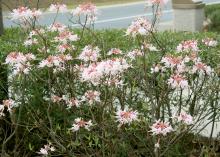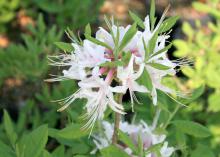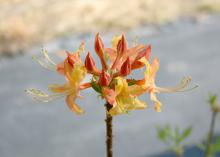Information Possibly Outdated
The information presented on this page was originally released on February 12, 2013. It may not be outdated, but please search our site for more current information. If you plan to quote or reference this information in a publication, please check with the Extension specialist or author before proceeding.
Native azaleas add charm, early blooms to landscapes
Many Mississippians are anticipating the first signs of the spring show put on in our landscapes by the popular, but nonnative Southern Indica azaleas. These shrubs hide behind their evergreen foliage, waiting to dazzle us with color.
Some gardeners consider native azaleas hard to grow, so we don’t see these varieties as much in Mississippi landscapes. Several species of native azaleas thrive in the Southeast. They may not be as showy as their evergreen cousins, but native azaleas are stunning in their own right.
All native azaleas are deciduous and are in the genus Rhododendron. The 15 species of native azaleas have bloom times from late March through summer. There are two early-blooming azaleas native to Mississippi.
Rhododendron canescens is commonly called piedmont azalea or honeysuckle azalea. Flowers are primarily shades of pink and rose with white accents. Driving across the Florida Panhandle this past weekend, I saw some great-looking honeysuckle azalea growing at a rest stop. As an added treat, these flowers are very fragrant and are pleasant on an early-morning garden stroll.
Rhododendron austrinum or Florida flame azalea has a range of colors that includes yellow, orange and fiery red.
What makes these early-blooming native azaleas really interesting is the sequence the flower buds go through before blooming. The first sign that something special is about to occur is when the flower buds swell from tight little clusters. These buds are a combination of flower and foliage, and they swell until they appear about to burst.
The flowers bloom on nearly naked stems. The flower buds on the outside of the cluster open first, followed by those in the middle. Flowers can be up to 1 1/2 inches across, but it is the stamens and pistils that add charm and interest. These structures extend out of the flower, giving it a delicate texture.
Growing native azaleas in containers can cause problems if you decide later to transplant the azalea into the ground. The root system of these plants is very fine and delicate and can actually stick to the inside of the container. Removing the plant from the container can damage these fine roots and make replanting unsuccessful.
Native azaleas grown in containers can be removed, but it must be done carefully. Before attempting to remove the plant, soak the entire container in a bucket of water. Once you have the container off, never cut or slice the root system like we do many other landscape plants. The damage may be irreversible.
When you have the plant out of the container, choose a landscape location that has filtered sunlight. Native azaleas thrive along the edges of woodlands, so be sure to plant yours in this type of location.
Planting natives in the correct places goes a long way toward ensuring you’ll have early-spring flowering from the native azaleas in your garden or landscape.










